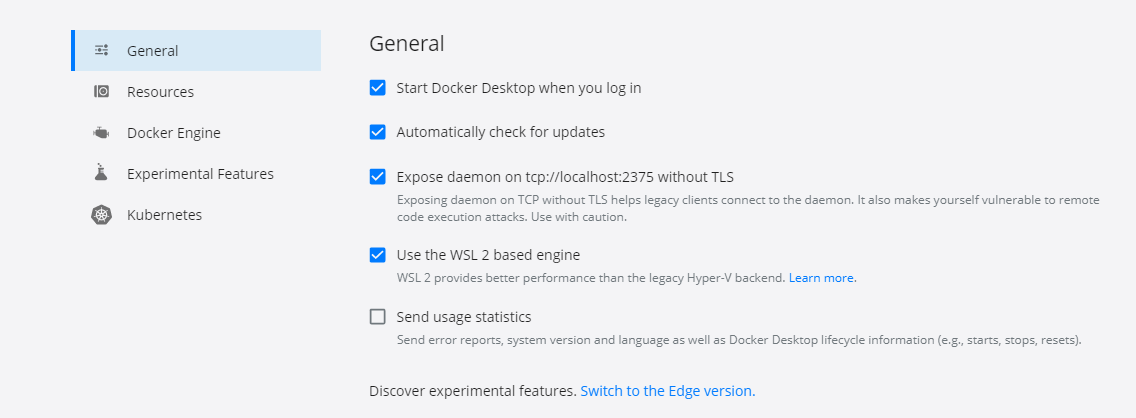- Make Docker Run Without Sudo Commands
- Make Docker Run Without Sudo Voice
- Make Docker Run Without Sudo File
- Make Docker Run Without Sudo Command
Run your CI/CD jobs in Docker containers. You can run your CI/CD jobs in separate, isolated Docker containers. When you run a Docker container on your local machine, it acts as a reproducible build environment. You can run tests in the container, instead of testing on a dedicated CI/CD server. To run CI/CD jobs in a Docker container, you need to. Preparing a machine to run with ROCm and docker. The following instructions assume a fresh/blank machine to be prepared for the ROCm + Docker environment; no additional software has been installed other than the typical stock package updating.
Table of Contents
- Alternate installation methods
- Certbot-Auto
Certbot is meant to be run directly on a web server, normally by a system administrator. In most cases, running Certbot on your personal computer is not a useful option. The instructions below relate to installing and running Certbot on a server.
System administrators can use Certbot directly to request certificates; they should not allow unprivileged users to run arbitrary Certbot commands as root, because Certbot allows its user to specify arbitrary file locations and run arbitrary scripts.
Certbot is packaged for many common operating systems and web servers. Check whethercertbot (or letsencrypt) is packaged for your web server’s OS by visitingcertbot.eff.org, where you will also find the correct installation instructions foryour system.
Note
Unless you have very specific requirements, we kindly suggest that you use the installation instructions for your system found at certbot.eff.org.
Certbot currently requires Python 2.7 or 3.6+ running on a UNIX-like operatingsystem. By default, it requires root access in order to write to/etc/letsencrypt, /var/log/letsencrypt, /var/lib/letsencrypt; tobind to port 80 (if you use the standalone plugin) and to read andmodify webserver configurations (if you use the apache or nginxplugins). If none of these apply to you, it is theoretically possible to runwithout root privileges, but for most users who want to avoid running an ACMEclient as root, either letsencrypt-nosudo or simp_le are more appropriate choices.
The Apache plugin currently requires an OS with augeas version 1.0; currently itsupportsmodern OSes based on Debian, Ubuntu, Fedora, SUSE, Gentoo and Darwin.
If you are offline or your operating system doesn’t provide a package, you can usean alternate method for installing certbot.
Most modern Linux distributions (basically any that use systemd) can installCertbot packaged as a snap. Snaps are available for x86_64, ARMv7 and ARMv8architectures. The Certbot snap provides an easy way to ensure you have thelatest version of Certbot with features like automated certificate renewalpreconfigured.
You can find instructions for installing the Certbot snap athttps://certbot.eff.org/instructions by selecting your server software and thenchoosing “snapd” in the “System” dropdown menu. (You should select “snapd”regardless of your operating system, as our instructions are the same acrossall systems.)
Docker is an amazingly simple and quick way to obtain acertificate. However, this mode of operation is unable to installcertificates or configure your webserver, because our installerplugins cannot reach your webserver from inside the Docker container.
Most users should use the instructions at certbot.eff.org. You should only useDocker if you are sure you know what you are doing and have a good reason to doso.
You should definitely read the Where are my certificates? section, in order toknow how to manage the certsmanually. Our ciphersuites pageprovides some information about recommended ciphersuites. If none ofthese make much sense to you, you should definitely use the installation methodrecommended for your system at certbot.eff.org, which enables you to useinstaller plugins that cover both of those hard topics.
If you’re still not convinced and have decided to use this method, fromthe server that the domain you’re requesting a certficate for resolvesto, install Docker, then issue a command like the one found below. Ifyou are using Certbot with the Standalone plugin, you will needto make the port it uses accessible from outside of the container byincluding something like -p80:80 or -p443:443 on the commandline before certbot/certbot.
Running Certbot with the certonly command will obtain a certificate and place it in the directory/etc/letsencrypt/live on your system. Because Certonly cannot install the certificate fromwithin Docker, you must install the certificate manually according to the procedurerecommended by the provider of your webserver.
There are also Docker images for each of Certbot’s DNS plugins availableat https://hub.docker.com/u/certbot which automate doing domainvalidation over DNS for popular providers. To use one, just replacecertbot/certbot in the command above with the name of the image youwant to use. For example, to use Certbot’s plugin for Amazon Route 53,you’d use certbot/dns-route53. You may also need to add flags toCertbot and/or mount additional directories to provide access to yourDNS API credentials as specified in the DNS plugin documentation.
For more information about the layoutof the /etc/letsencrypt directory, see Where are my certificates?.
Warning
While the Certbot team tries to keep the Certbot packages offeredby various operating systems working in the most basic sense, due todistribution policies and/or the limited resources of distributionmaintainers, Certbot OS packages often have problems that other distributionmechanisms do not. The packages are often old resulting in a lack of bugfixes and features and a worse TLS configuration than is generated by newerversions of Certbot. They also may not configure certificate renewal for youor have all of Certbot’s plugins available. For reasons like these, werecommend most users follow the instructions athttps://certbot.eff.org/instructions and OS packages are only documentedhere as an alternative.
Arch Linux
Debian
If you run Debian Buster or Debian testing/Sid, you can easily install certbotpackages through commands like:
If you run Debian Stretch, we recommend you use the packages in Debianbackports repository. First you’ll have to follow the instructions athttps://backports.debian.org/Instructions/ to enable the Stretch backports repo,if you have not already done so. Then run:
Make Docker Run Without Sudo Commands
In all of these cases, there also packages available to help Certbot integratewith Apache, nginx, or various DNS services. If you are using Apache or nginx,we strongly recommend that you install the python-certbot-apache orpython-certbot-nginx package so that Certbot can fully automate HTTPSconfiguration for your server. A full list of these packages can be foundthrough a command like:
They can be installed by running the same installation command above butreplacing certbot with the name of the desired package.
Ubuntu
If you run Ubuntu, certbot can be installed using:
Optionally to install the Certbot Apache plugin, you can use:
Fedora

FreeBSD
- Port:
cd/usr/ports/security/py-certbot&&makeinstallclean - Package:
pkginstallpy27-certbot
Gentoo
The official Certbot client is available in Gentoo Portage. From theofficial Certbot plugins, three of them are also available in Portage.They need to be installed separately if you require their functionality.
Note
The app-crypt/certbot-dns-nsone package has a differentmaintainer than the other packages and can lag behind in version.
NetBSD
- Build from source:
cd/usr/pkgsrc/security/py-certbot&&makeinstallclean - Install pre-compiled package:
pkg_addpy27-certbot
OpenBSD
- Port:
cd/usr/ports/security/letsencrypt/client&&makeinstallclean - Package:
pkg_addletsencrypt
Other Operating Systems
OS packaging is an ongoing effort. If you’d like to packageCertbot for your distribution of choice please have alook at the Packaging Guide.
We used to have a shell script named certbot-auto to help people installCertbot on UNIX operating systems, however, this script is no longer supported.If you want to uninstall certbot-auto, you can follow our instructionshere.
When using certbot-auto on a low memory system such as VPS with less than512MB of RAM, the required dependencies of Certbot may fail to build. This canbe identified if the pip outputs contains something like internalcompilererror:Killed(programcc1). You can workaround this restriction by creatinga temporary swapfile:
Disable and remove the swapfile once the virtual environment is constructed:
Make Docker Run Without Sudo Voice
Installation from source is only supported for developers and thewhole process is described in the Developer Guide.
Make Docker Run Without Sudo File
Warning
Please do not use pythoncertbot/setup.pyinstall, pythonpipinstallcertbot, or easy_installcertbot. Please do not attempt theinstallation commands as superuser/root and/or without virtual environment,e.g. sudopythoncertbot/setup.pyinstall, sudopipinstall, sudo./venv/bin/.... These modes of operation might corrupt your operatingsystem and are not supported by the Certbot team!
A container is an executable unit of software where an application and its run time dependencies can all be packaged together into one entity. Since everything needed by the application is packaged with the application itself, containers provide a degree of isolation from the host and make it easy to deploy and install the application without having to worry about the host environment and application dependencies.
Docker is an open source platform for creating, deploying, and running containers. Docker is included in JetPack, so running containers on Jetson is easy and does not require any installation.
NVIDIA NGC is a hub for GPU-optimized deep learning, machine learning, and high-performance computing (HPC) software. NGC hosts containers for the top AI and data science software-- all tuned, tested and optimized by NVIDIA. Containers on NGC provide powerful and easy-to-deploy software proven to deliver fast results, allowing users to build solutions from a tested framework.
Visit NGC portal for more information at https://www.nvidia.com/en-us/gpu-cloud/.
Jetson Containers on NGC
Several containers for Jetson are hosted on NVIDIA NGC. Visit the Jetson cloud-native page on the list of containers for Jetson hosted on NGC.
Downloading the Container
To download a container, one needs to use the “docker pull” command.
Usage:
See docker pull documentation for details.
Follow the example below to download the L4T-base container from NGC:
Note that nvcr.io/nvidia/l4t-base is the name of the container and r32.4.3 is the tag. Tags provide a way to version control the containers.

Listing the Containers
You can view a list of containers already pulled to your developer kit using the “docker image ls” command.

Usage:
See docker image ls documentation for details.
Make Docker Run Without Sudo Command
Running Containers
Containers are run using docker run command.
Usage:
See docker run documentation for details.
Follow the example below to run the L4T-base container:
Visit the L4T-base container page for explanation on the above docker run command.
Congratulations on running your first container on Jetson!
